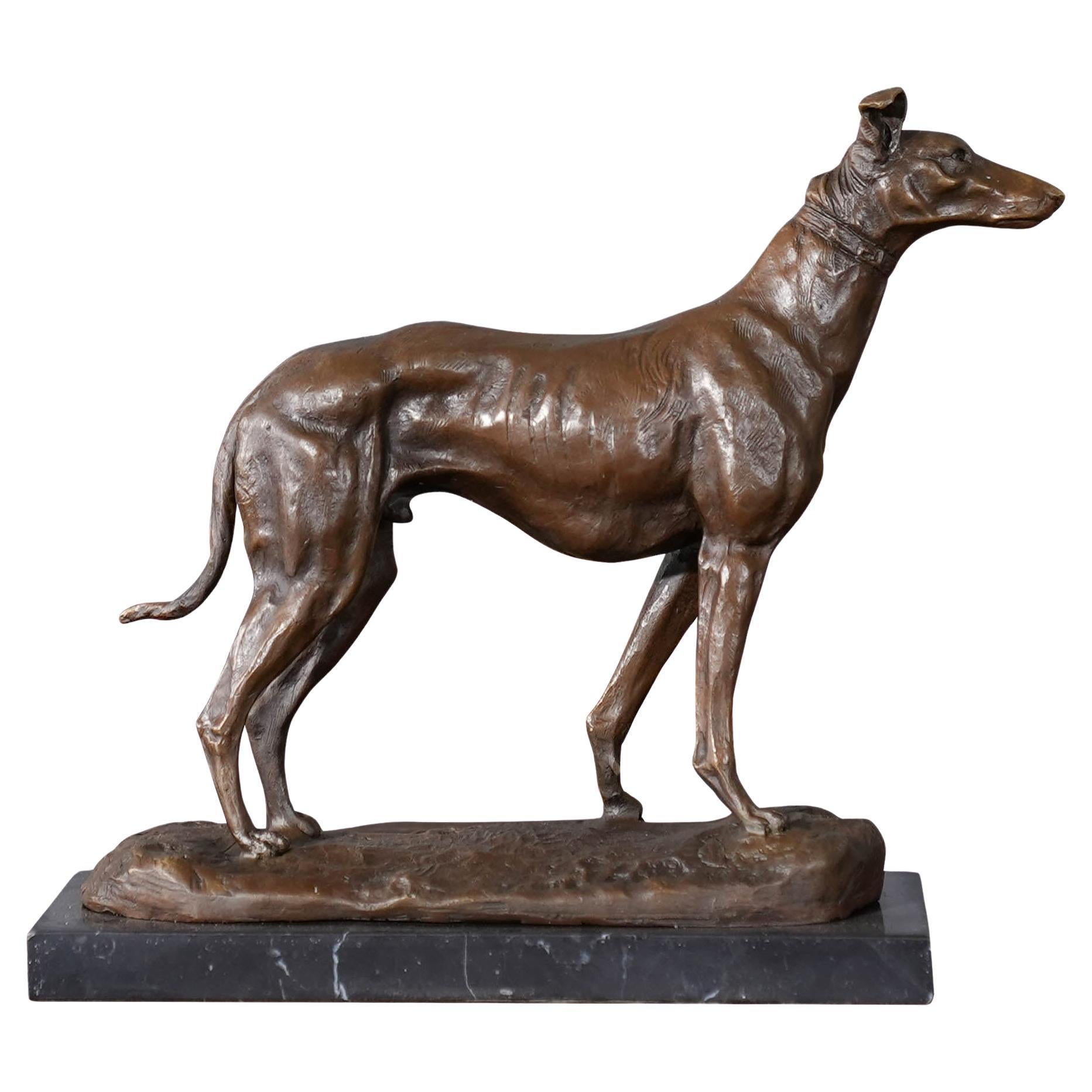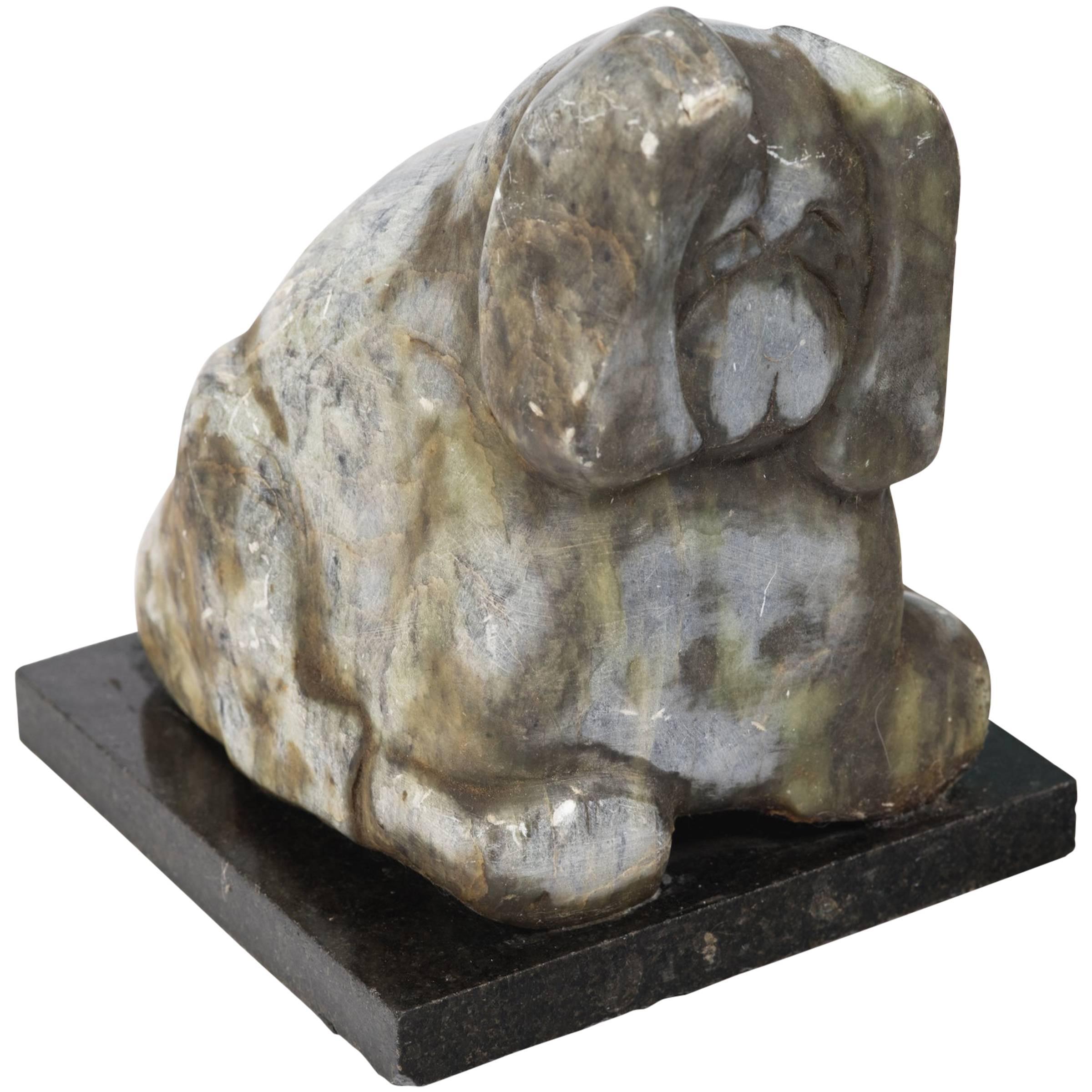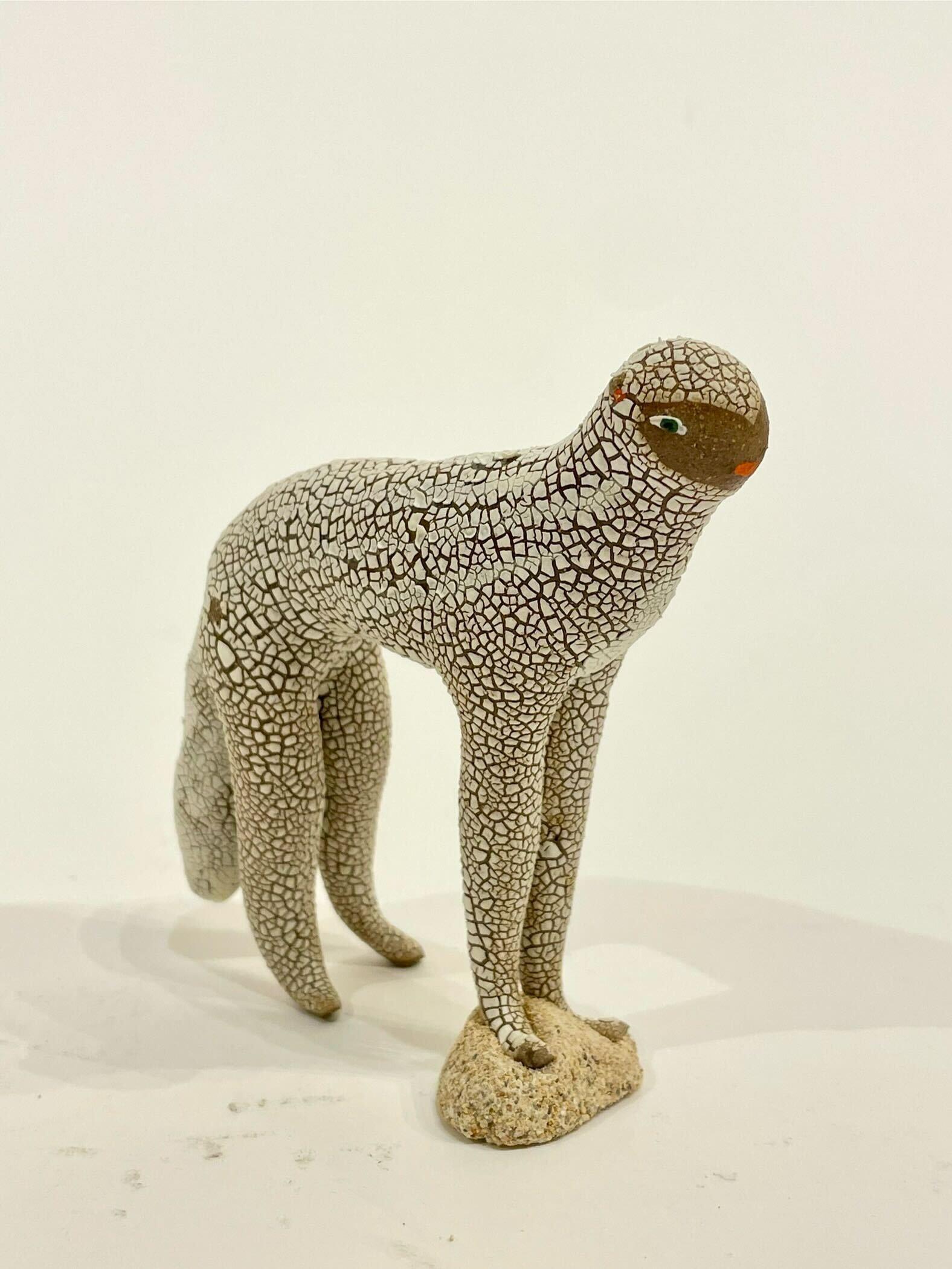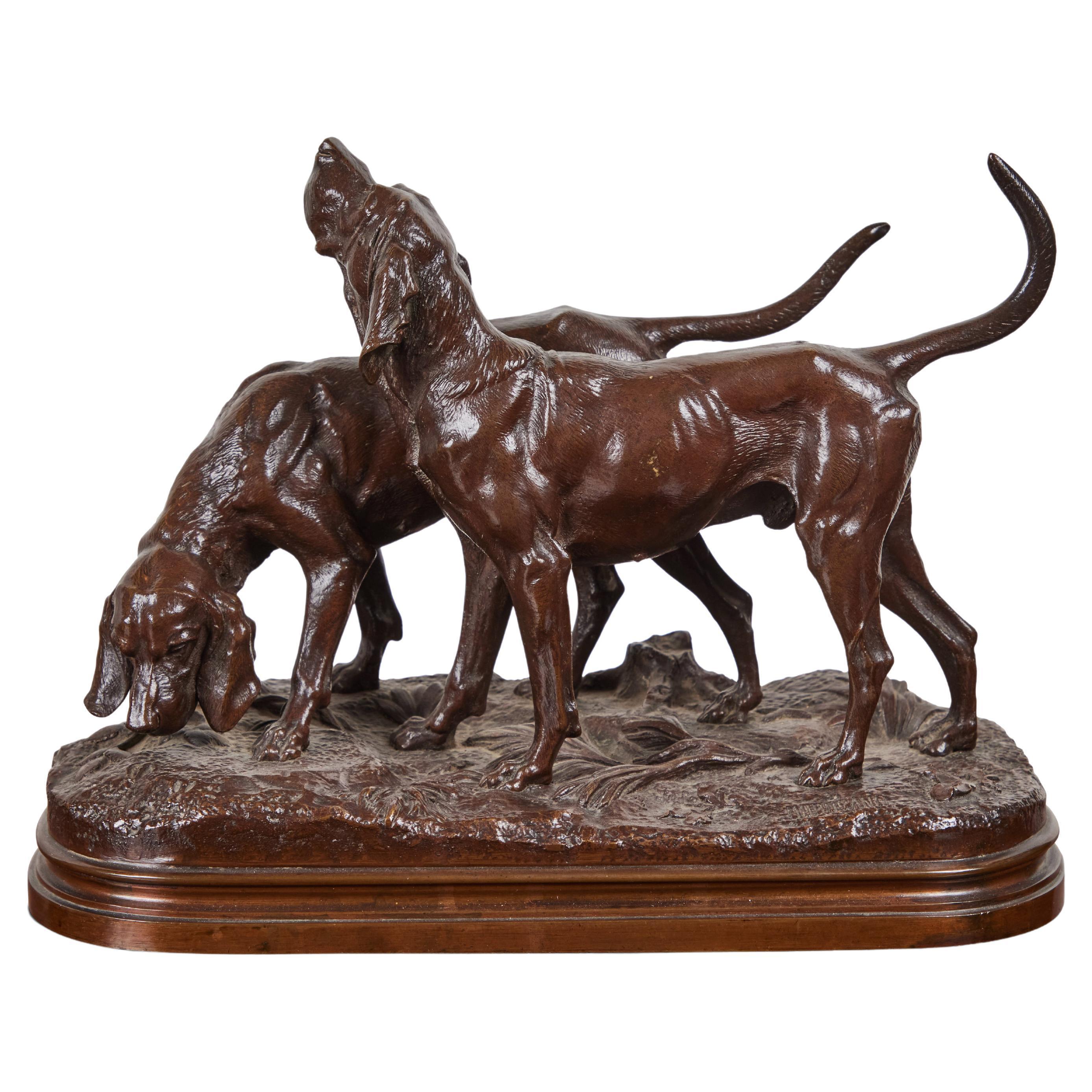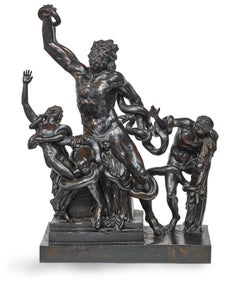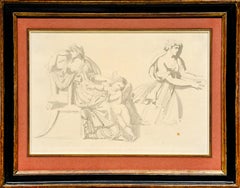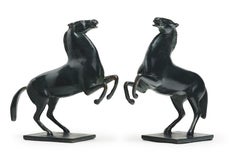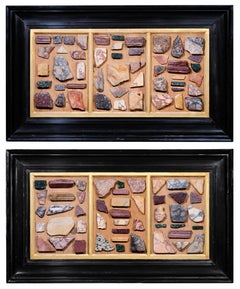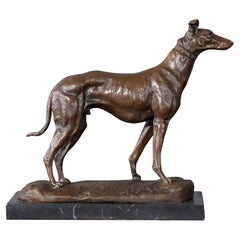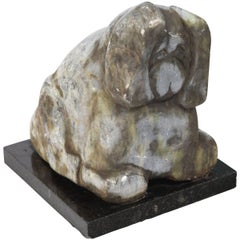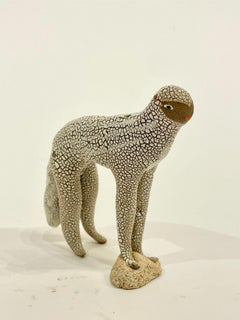Want more images or videos?
Request additional images or videos from the seller
1 of 10
Dog scratching its ear
$6,343.20
£4,733.89
€5,350
CA$8,856.37
A$9,659.40
CHF 5,078.52
MX$116,846.94
NOK 63,373.59
SEK 59,882.02
DKK 40,740.60
About the Item
This amusing naturalistic sculpture in silver-plated pewter was probably made in the 17th century by Georg Schweigger. Inspired by a model created by another Nuremberg sculptor, Peter Flötner, it bears witness to the persistence during the baroque era of the naturalistic taste that emerged in the Renaissance. Intended as an ornament for some Kunstkammer, or cabinet of curiosities, this sculpture was a great success, as can be seen from the presence of similar works in many European museums.
1. Georg Schweigger
Georg Schweigger was a baroque sculptor and medal founder from Nuremberg, known mainly for his small-scale works in stone, carved wood and cast metal. His only large-scale work, the Neptune Fountain, has been in the Petershof Palace, the summer residence of the Tsars near St. Petersburg, since 1797. This monumental sculpture demonstrates his taste for the representation of movement, which we find in this small piece, inspired, as we shall see, by earlier models.
2. The success of a naturalistic theme
As is often the case in the history of art, the source of the Dog scratching his ear theme probably comes from an engraving, and more precisely from one made in Strasbourg in 1480 or in Aschaffenburg in 1481 by the Master of the Housebook, an anonymous engraver working in southern Germany at the end of the 15th century.
This engraving seems to have been Peter Flötner’s (1490 - 1546) source of inspiration. Peter Flötner was a sculptor and engraver who settled in Nuremberg in 1522. The Louvre Museum also has a gilded lead statuette dated between 1500 and 1515 (on deposit at the Musée de L'Œuvre in Strasbourg), which in turn is thought to have served as a model for other known statuettes.
This model was later taken up by the Frenchman Barthélemy Prieur (1526 - 1611), although it is not clear whether these two sculptors were directly inspired by the engraving of the Master of the Housebook or whether, as would seem more likely, Barthélemy Prieur was inspired by Peter Flötner. A sculpture attributed to Barthélemy Prieur, believed to date from the 1600s, was sold at Sotheby's Paris on 14 June 2022 for €18,270.
The later models attributed to Georg Schweigger often show variations on the Flötner one, such as the tongue hanging down or the tail raised (as in the model attributed to Barthélemy Prieur). The one presented here corresponds to the Flötner model, but the regularity of the original silver threaded fixing rods suggests that it was made after the beginning of the 17th century, and is therefore contemporary to Georg Schweigger’s activity.
The statuette of the Dog scratching his ear was a famous subject, of which several versions by different artists appear in many other museums, including the Grünes Gewölbe in Dresden, as well as the museums of Berlin (since 1701), Braunschweig, Vienna, Cleveland and Munich.
Main bibliographic elements :
U. Berger, V. Krahn, Bronzen der Renaissance und des Barock, Herzog-Anton Ulrich Museum, Braunschweig, 1994, pp.275 - 276, figs. 222 and 223.
V. Krahn, Von allen Seiten schön. Bronzen der Renaissance und des Barock, Berlin, 1996, p. 544, no. 204.
- Attributed to:Georg Schweigger (1613 - 1690, German)
- Dimensions:Height: 2.13 in (5.42 cm)Width: 2.57 in (6.53 cm)Depth: 2.57 in (6.53 cm)
- Medium:
- Movement & Style:
- Period:
- Condition:17th century silver-plated pewter sculpture (re-silvered) Height: 2 1/8” (54 mm); width: 2 9/16” (65 mm), depth: 2 9/16” (65 mm) On a black marble base ¾” x 4 ¼” x 3 13/16” (20 mm x 108 mm x 97 mm).
- Gallery Location:PARIS, FR
- Reference Number:1stDibs: LU1568210788782
About the Seller
5.0
Vetted Professional Seller
Every seller passes strict standards for authenticity and reliability
Established in 2020
1stDibs seller since 2021
10 sales on 1stDibs
- ShippingRetrieving quote...Shipping from: PARIS, France
- Return Policy
Authenticity Guarantee
In the unlikely event there’s an issue with an item’s authenticity, contact us within 1 year for a full refund. DetailsMoney-Back Guarantee
If your item is not as described, is damaged in transit, or does not arrive, contact us within 7 days for a full refund. Details24-Hour Cancellation
You have a 24-hour grace period in which to reconsider your purchase, with no questions asked.Vetted Professional Sellers
Our world-class sellers must adhere to strict standards for service and quality, maintaining the integrity of our listings.Price-Match Guarantee
If you find that a seller listed the same item for a lower price elsewhere, we’ll match it.Trusted Global Delivery
Our best-in-class carrier network provides specialized shipping options worldwide, including custom delivery.More From This Seller
View AllLaocoön and his Sons, an exceptional bronze sculpture by Giacomo Zoffoli
Located in PARIS, FR
This exceptional bronze group (unpublished), executed in Rome in the second half of the 18th century, bears witness to the fascination with the Laocoön since its discovery on January...
Category
1770s Italian School Nude Sculptures
Materials
Bronze
Frieze of antique figures, a drawing by the sculptor Antoine-Denis Chaudet
Located in PARIS, FR
Faithful to the neo-classical taste, sculptor Antoine-Denis Chaudet presents us with a frieze of antique figures executed in gray wash over pencil strokes, which is likely inspired b...
Category
Early 1800s Old Masters Figurative Drawings and Watercolors
Materials
Paper, Pencil, Ink
Pair of Prancing Horses, two bronzes signed and numbered by Arno Breker
Located in PARIS, FR
An official artist of the Nazi regime, trained in Montparnasse in the 1930s, Arno Breker continued to sculpt after the fall of the Third Reich, producing large-scale public commissions in Germany and portraits of prominent figures. The two small bronzes presented here, dated around 1978, are part of a long tradition of prancing horses dating back to antiquity. The asymmetrical treatment of the two front legs and the inclination of the head make these two copies of the same artwork a highly decorative pair.
1. Arno Breker, a prolific sculptor, from the Bohemia of Montparnasse to the commissions from the Third Reich ... and from the Federal Republic of Germany
The son of a stone carver, Arno Breker studied fine art and anatomy in his native Elberfeld. At the age of 20, he entered the Düsseldorf Academy of Art. He moved to Paris in 1926, where he continued his training in the studio of Maillol, who dubbed him "the German Michelangelo of the twentieth century". He shared a studio with Alexandre Calder and frequented Jean Cocteau, Foujita, Brancusi, Pablo Picasso and other artists of the bohemian Paris of the time. It was also in Paris in 1933 that he met Demetra Messala, the daughter of a Greek diplomat who posed for Maillol and Picasso, whom he married in 1937. Having won the Prussian Prix de Rome in 1932, he left Paris to stay at the Villa Massimo, the German Academy in Rome.
Returning to Germany in 1934, his style evolved towards a more marked imitation of ancient sculpture. He created two monumental statues for Berlin's Olympic Stadium, before being appointed professor at the Berlin College of Fine Arts in 1937. He came to the attention of the Reich Propaganda Ministry, which awarded him several commissions and provided him with three large studios in which Breker produced many monumental sculptures to the glory of the regime. On June 23, 1940, Breker accompanied Adolf Hitler during a visit to Paris. During the Occupation, his political connections enabled him to intervene on behalf of many artists pursued by the Nazis: for example, he protected Pablo Picasso (then a Communist) from Kommandantur officers.
Most of Arno Breker's work was destroyed in Berlin at the end of the war in 1945 by bombing and intentional destruction perpetrated by soldiers of the victorious powers. After the fall of the Nazi regime, however, Arno Breker was never prosecuted. He opened a new studio in Düsseldorf, where he sculpted until his death in 1991.
He then carried out several public commissions in Germany (Bayreuth, Wuppertal), as well as portraits of numerous personalities, including King Mohammed V of Morocco, Léopold Sedar Senghor (commissioned by the Académie Française in 1978) and the two chancellors of the Federal Republic of Germany, Konrad Adenauer and Ludwig Erhard. The Arno Breker Museum in Nörvenich is now exhibiting some of his artworks.
2. Related artworks: from the Wild Horses of the Quirinal to the Horses of Marly
The prancing horse is a major iconographic theme, found in a series of sculptures from Antiquity, the Renaissance and the Classical Age. Various photos from Arno Breker's studio in Berlin confirm the predominant place of equine representations in his work (alongside male nude statues), and confirm that this reduced version created in 1978 is part of the artist's preferred repertoire.
Prancing horses are generally associated with a male figure in a group that, through a reference drawn from Antiquity, symbolizes man's domination over nature. In this respect, it is very interesting to compare our small bronzes with the horse forming part of a large sculpture by Arno Breker (made in 1936 and probably destroyed in 1945) depicting Alexander taming Bucephalus.
This statue is itself directly inspired by one of the best-known works of 18th-century French sculpture...
Category
1970s Art Deco Figurative Sculptures
Materials
Bronze
"The collection of a lifetime" : two triptychs featuring antique marble samples
Located in PARIS, FR
These two highly decorative triptychs feature 94 samples of antique marble, presumably collected by the same collector in the early 20th century from archaeological sites in Rome and...
Category
Early 20th Century Assemblage More Art
Materials
Alabaster, Granite, Marble
Diana and Actaeon, a Mannerist painting after Joseph Heintz the Elder
Located in PARIS, FR
This painting seduced us with its rich colors. Depicting Diana and her companions surprised by Actaeon, it was inspired by an engraving by Aegidius Sadeler II after a painting by Jos...
Category
17th Century Old Masters Nude Paintings
Materials
Oil, Wood Panel
Allegory of Chastity, a drawing attributed to G. Porta with great provenance
Located in PARIS, FR
This magnificent drawing from the Venetian Renaissance intrigues us in many ways. It depicts an allegorical composition whose meaning partly escapes us: a veiled figure seated on a stone bench (which we have identified as Chastity), seems to be turning away from a woman's bust beside her, below which are two rabbits, a traditional allegory of fertility, but also sometimes of lust.
This drawing, executed on blue paper, undoubtedly belongs to the Venetian Renaissance. The inscriptions on the back of the old mounting board indicate the various attributions considered by its last owner, the British painter and art historian Sir Lawrence Gowing. We have retained the attribution to Giuseppe Porta proposed by art historian John Arthur Gere as the most relevant.
We were incredibly fortunate to find a hexagonal frame of a very similar format for this drawing, the upper corners of which were formerly cut (irregularly). This 17th-century Dutch frame comes from an aristocratic collection in Lombardy, and creates a kind of fascinating chase around this Venetian drawing...
Category
16th Century Figurative Drawings and Watercolors
Materials
Chalk
You May Also Like
Dog on Marble Base
Located in Annville, PA
Graceful even when standing still the Dog on Marble Base is a striking addition to any setting. Using traditional lost wax casting methods the Dog on Marble Base statue...
Category
2010s Animal Sculptures
Materials
Bronze
$305 / item
Dog with Bird
By David L. Deming
Located in Sante Fe, NM
David L. Deming’s world of lively canine sculptures captures the artist’s love for dogs and presents a whimsical look at four-legged behavior at its best.
His extensive and unique collection of painted steel and lacquered steel dog sculptures...
Category
1990s Post-Modern Figurative Sculptures
Materials
Steel
Price Upon Request
Signed Carved Marble Sculpture of Dog
Located in Tarrytown, NY
Signed carved marble sculpture of dog.
Category
Vintage 1970s Animal Sculptures
White Dog
By Robin Whiteman
Located in Bozeman, MT
Robin has worked with clay since the age of eleven. Her sculptures have ranged in size from life sized sculptures to the diminutive porcelain pieces. She has been a resident artist a...
Category
2010s Contemporary Sculptures
Materials
Clay, Glaze
Hunting dog on the prowl / - Following the scent -
By Jules Moigniez
Located in Berlin, DE
Jules Moigniez (1835 Senlis - 1894 St-Martin-du-Tertre), Hunting dog on the prowl, around 1880. Dark patinated bronze with naturalistic terrain plinth, 16 cm (height) x 30 cm (length...
Category
1890s Naturalistic Figurative Sculptures
Materials
Bronze
Signed, Bronze Hound Sculpture
By Alfred Dubucand
Located in Los Angeles, CA
A lively, beautifully cast, patinated bronze sculpture of two hounds on a lush forest floor by listed French artist, Alfred Dubucand (1828-1894).
A proponent of Romantic Realism, Dubucand was a prize pupil of the renowned founder of the French Animaliers School, Antoine-Louis Bayre (1796-1875) whose patrons were representatives of the state government and royalty including the Duke of Orleans...
Category
1880s Sculptures
Materials
Bronze
More Ways To Browse
Antique Dog
Antique Silver Dog
Antique Pewter Plates
Marble Dog Sculpture
Large Antique Fountain
Walter Furlan Picasso
Ai Weiwei Coca
Anne Anderson
Anthony Theakston
Anton Smit
Blek The Rat
Bronze Sculpture 2 Birds
Burning Man Sculpture
Camille Claudel Sculptures
Doug Robinson
Erte Rigoletto
Isabelle Thiltges
Jean Louis Corby
